A 60-year-old male presented with progressive development of asymptomatic facial discolouration, affecting sun-exposed areas, in the previous 18 months. Physical examination revealed photodistributed, blue-gray hyperpigmentation of the face, sparing the eyelids and nasolabial folds (Figure 1). The patient was being treated with amiodarone, at a dose of 400mg daily, for the last 2 years, with an estimated cumulative dose of 300 g, for cardiac arrhythmia. A diagnosis of amiodarone-induced hyperpigmentation was performed. The patient was advised to avoid direct excessive sunlight exposure and to use sunscreen products with high protection factor against UV-A and UV-B radiation. Switching from amiodarone to another antiarrhythmic drug was also suggested, if considered adequate by the patient’s cardiologist.
Dermatological complications of amiodarone occur in up to 75% of patients with prolonged use of the drug, and the main skin changes encountered are phototoxic and photoallergic reactions, as well as hyperpigmentation.1 Amiodarone hyperpigmentation occurs after an average of 20 months of continuous treatment and a cumulative dose of 160 g, typically with blue-grey discoloration of the face, ears and palms.1,2 Young age, total dose and duration of treatment, rate of amiodarone metabolism, frequency and intensity of exposure to sun and photosensitivity influence the likelihood of skin discolouration.3 The mechanism by which these changes occur is not precisely understood: deposition of lipofuscin aggregates or insoluble compounds of amiodarone and phospholipids, as well as inflammation around microvessels, have been proposed.1 Skin changes are usually reversible with drug withdrawal, although it may take a few months to several years as a consequence of slow elimination of amiodarone and its metabolites.1,2 There have been reports of significant efficacy of cosmetic laser application, which could possibly be very beneficial in patients with too many cardiovascular complications to allow amiodarone withdrawal.1,3
Figura I

Figure 1 - Blue-gray hyperpigmentation of the face.
BIBLIOGRAFIA
1. Jaworski K, Walecka I, Rudnicka L, Gnatowski M, Kosior D. Cutaneous adverse reactions of amiodarone.Med Sci Monit.2014;20:2369–2.
2. Ammoury A, Michaud S, Paul C, Prost-Squarcioni C, Alvarez F, Lamant L, et al. Photodistribution of blue-gray hyperpigmentation after amiodarone treatment: molecular characterization of amiodarone in the skin.Arch Dermatol.2008;144(1):92–6.
3. Wiper A, Roberts DH, Schmitt M. Amiodarone-induced skin pigmentation: Q-switched laser therapy, an effective treatment option.Heart.2007;93(1):15.


